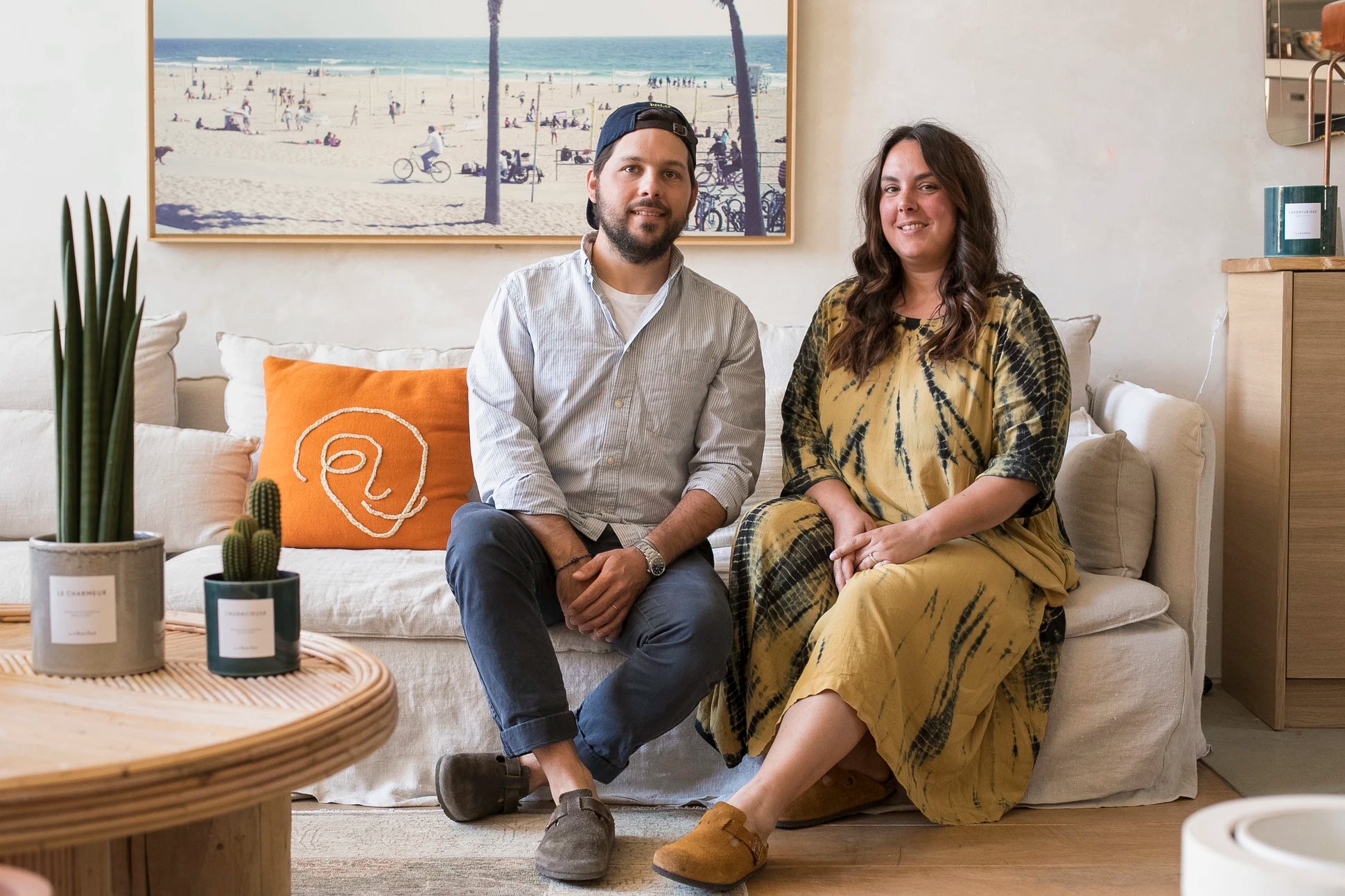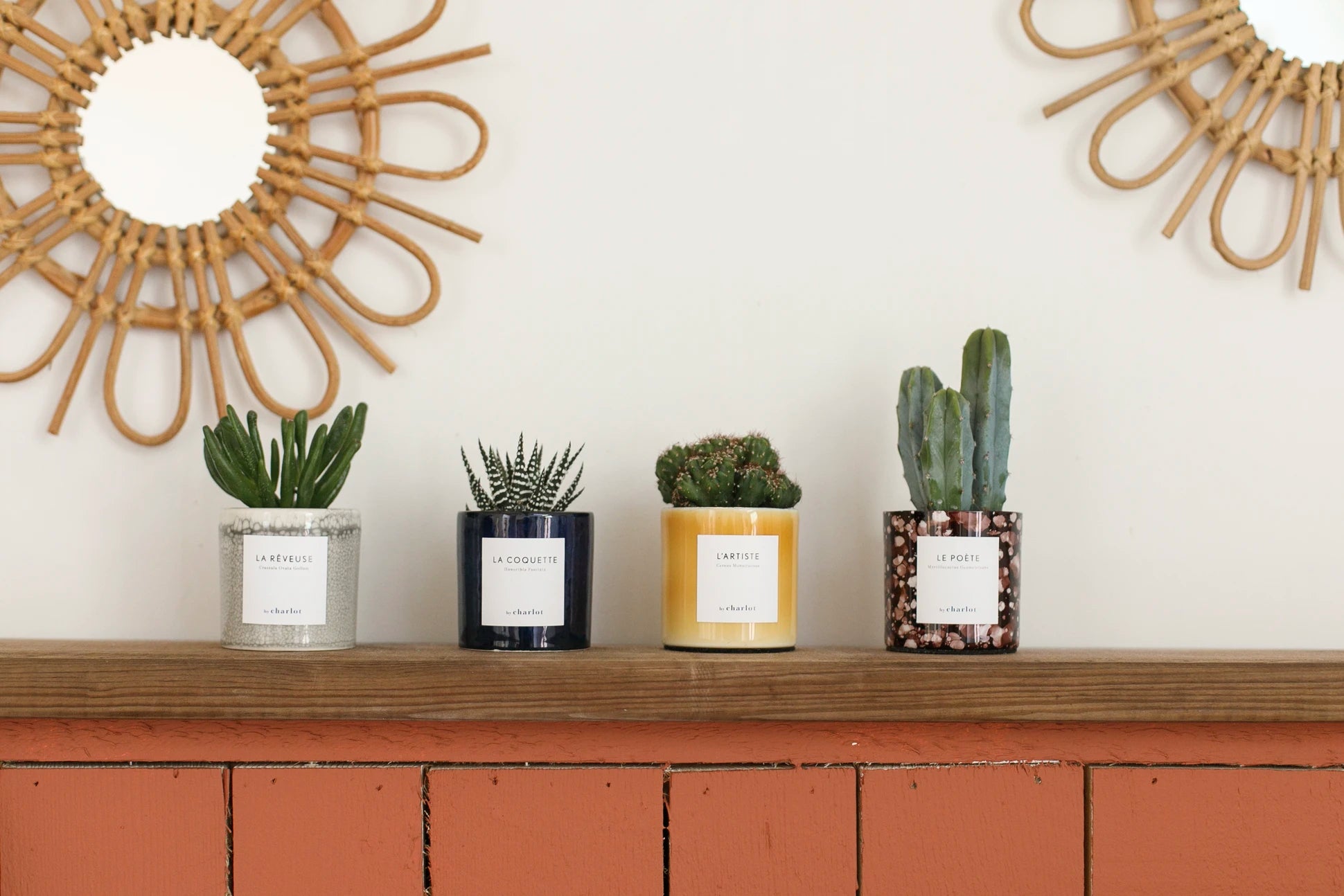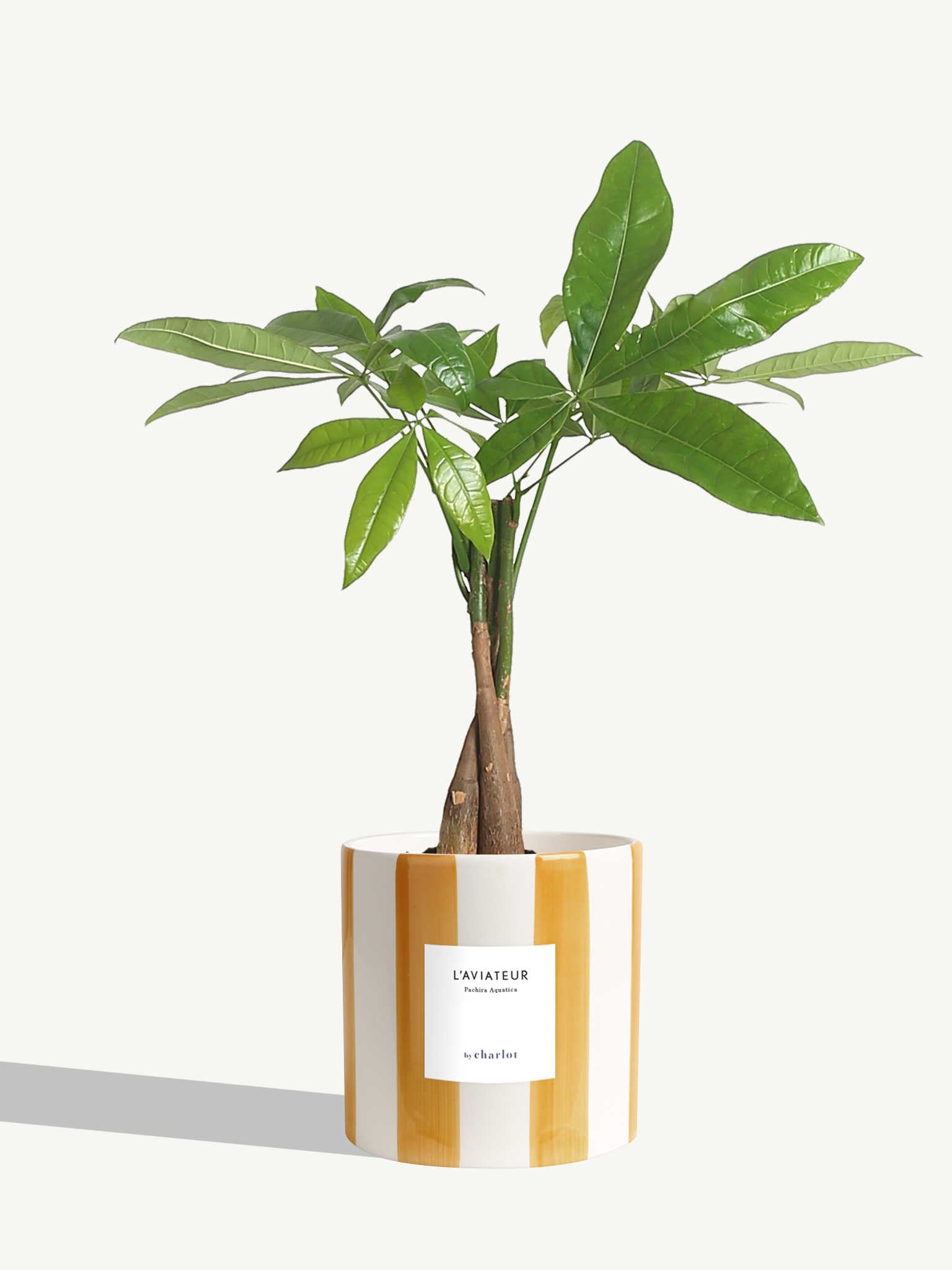For this new interview, By Charlot takes you to the seaside to discover Maison Acacia, a guesthouse that smells like vacation. Vintage surfboards hanging on the wall, plants blooming everywhere, a shaded patio reserved for guests... The scene is set: we're at Léa and Thomas's place.

Hello Léa, hello Thomas, tell us a little about yourself and your background...
Léa : Hello, we are Léa and Tom, we are two creative personalities. We have backgrounds linked to art because I am a photographer myself and Tom is a decorator. Over the years, we have created projects together that highlight living spaces. We started by opening a small café in the Saint-Ouen flea market, we were then immersed in the world of flea markets and antiques. Then we moved to the South and we set up a guesthouse called La Pinède . It was our first reception venue in the hotel industry. Finally we opened this place, Maison Acacia, which is a guesthouse with hybrid codes. It is a living and reception space, which mixes hotel, restaurant, boutique, and allows us to welcome our clients in the best conditions.
Image with text
Thomas : I've loved it since I was little, it's something my father passed on to me. He has a habit of never throwing things away, which means we hoard a lot, but it's a great pleasure for me to take out things I've been hoarding for 10 or 15 years. It's less fun for Léa, but it's true that I love recycling or repurposing, it's very satisfying and it costs less. And now I enjoy teaching this to others, through tutorials or videos.
Image with text
Thomas : There are a lot of inspirations that come from our travels, from things we see that are not affordable, so we try to transcribe them with our own means. When we look at the decor that makes up our universe, we have few edited or signed pieces, these are elements that come from large retailers and that we mix with others. Typically, the coffee table in the living room is made of logs on which I put tagine trivets. The same table would cost an exorbitant price in a referenced store. So we really want to make our own sauce and complement it perfectly with the pieces that we want to have in our interior.
Léa : We developed this together in our everyday lives and during our travels. This ability to isolate and hunt for objects that we spot during our travels and that would seem insurmountable to recreate. But we have no limits when it comes to that. We both know that nothing is impossible. Using recycled materials, old objects, vintage pieces, we can give new life to objects and bring them up to date. Being able to make them functional and usable on a daily basis is something we've both always done and love to share. That's what makes us a good pair in life but also in work.
« There are a lot of inspirations that come from our travels, from things we see that are not affordable, so we try to transcribe them with our own means. »

Do you follow DIY and tutorial accounts or do ideas come naturally out of habit?
Thomas : It depends. Sometimes we see things that have been done and we think they're really cool, but we could work on them differently. There are also ideas that are purely inspirational, that come to us after a walk in the calanques or elsewhere. It's very varied. But I must admit that Pinterest is also an incredible platform for picking up ideas from lots of different countries.
Léa : We like natural materials that are easy to use, like wood or other transformable materials. Tom has the ability to cut, saw, and plane. We don't really have any limits because he has a level of DIY that allows him to make things. So it's nice to have ideas without the frustration of not being able to make them ourselves.
Thomas : It's even becoming a challenge for us. For example, we wanted the outdoor table to be big, beautiful, and wide, and the problem is that it quickly becomes very expensive in stores, so we decided to make it ourselves.
Léa : We started with an inspiration we spotted in a hotel in the desert. We bring back a lot of ideas from abroad. It's not that France doesn't inspire us, but we've been lucky enough to travel to countries where DIY isn't a trend but a lifestyle. In some countries in the southern hemisphere, for example, everything is done in a daring, artisanal way, which influences us a lot now that we've seen that it's possible to make beautiful things from very little.

You communicate a lot on Instagram, how do you manage your social networks?
Léa : On Instagram, we show what we want to show. It's not always a reflection of our reality, which is kind of the idea. But it's still a part of our daily lives. Sometimes I show the flaws in the project, the difficult moments. I try to be a little transparent, but that's not the point either. I'm not here to confide in my followers; my goal is to inspire, to inspire, to bring sunshine—especially this year—but without being utopian.
Thomas : Léa manages this part. Editorial, storytelling, etc. Through content production, we try to inspire people, make them travel, escape, and provide them with visual pleasure at a time when we all need it.

In fact, well before the start of the pandemic, you decided to leave the capital and prioritize a better quality of life. What motivated your departure at the time, and what did you find in the south that you missed in Paris?
Thomas : The move came quite naturally when we had our first daughter, Java. We quickly realized that having outdoor space is a real plus for raising a child. In the Paris region, we didn't have the budget. My parents have a house in the south, so we wanted to be closer to them.
Léa : We knew we wanted to expand on our little café in Saint-Ouen, by increasing the size of the place so we could host guests, and we found a house in Marseille that offered us this possibility. This project of living in the South, which could have taken 2-3 years, finally took 6 months because we found La Pinède . And for Maison Acacia , our ambition was to have our own little hotel before we turned 40. We set ourselves goals, and the South offers us these possibilities, not only because real estate prices are more reasonable, but also because there are lots of things to do here. It's very inspiring. We live in a city where people go on vacation, so we're already in a setting that lends itself to it. I am of Mediterranean origin, it is ingrained in me, I had not realized it until I lived by the sea. Ultimately, living here is a chance that we appreciate every day.

At La Pinède, you developed an original concept: every item in the house was for sale. You've reproduced it here. Can you tell us more about it?
Thomas : This idea came to us during a trip to Argentina, near Salta. We were staying in a Boutique Hotel, whose concept was normally to buy the furniture we liked, as its name suggests. But we wanted to bring back a piece of bed upholstered in an Aztec fabric and it wasn't for sale, so we thought it was a shame. That's where we started, we tested the concept in our café in Saint-Ouen and we decided to keep this guiding principle for the other places we created.
Léa : It started with a personal desire. Instead of stealing the objects we loved from our stays abroad from the hotel, we thought we wanted to make it possible to leave with a decorative favorite that people might have when they came to our place. It's also a way for us, who are addicted to change, to renew the place, because if an emblematic piece from one of the rooms is purchased, it will have to be replaced and this allows us to avoid having a fixed decor. It's also a way to renew ourselves, to create change for our loyal customers, new content, and it's a synergy that is very pleasant to experience.
Thomas : We have containers in Paris and Marseille, filled with things we brought back from our travels, or things we had at home but no longer want and that we'll be delighted to find in five years. We also shop a lot at Emmaüs.
Léa : There's the stock, and then there are the pieces we don't want to part with because we care too much about them, because they have sentimental value. But other than that, we're not too attached to material things, so we don't hesitate to replace or modify them. That's how we operate, and thanks to our containers, we have our own little flea market.
« We were very sensitive to the art of hosting, with that little extra something, the little decoration that will make the difference. »

Has decoration always been part of your DNA?
Léa : Yes, because my mother is a decorator. She passed on to me her notion of beauty and the art of living, particularly through the art of the table. I was raised with these values, and my father also adhered to these codes. Nothing was left to chance in the homes I grew up in.
Thomas : For my part, we were very sensitive to the art of hosting, with that little extra something, the little decorations that will make the difference. The goal is to please, to amaze, to surprise, and to leave good memories.
Léa : We share these common values of kindness and generosity, and today we put them to the service of our projects as if they were our friends we were hosting. We've always loved it, and today it's become our job. We try to give a very family atmosphere to the places we create.
Thomas : And the best compliment we can get is when a customer says, "I felt at home." It's very gratifying.

Among the By Charlot plants, which is your favorite, the one that best reflects the spirit of Maison Acacia?
Léa : I'm very inspired by South America, so I naturally gravitated toward cacti and succulents, which are very common in the By Charlot range. We also gravitated toward the words on the pots, because L'Audacieuse or L'Aventurière clearly evoke our project. Setting up this project with two children and no one to help us was quite an adventure. We needed audacity to carry out this bold project. And Le Charmeur speaks to us because we want to charm our customers with our social media and our way of life, in an authentic way. Charm is also part of our relationship; it's a word I really like.
Thomas : For my part, I was hooked on the pots. Léa is the one who manages the plants in the house and has a very insightful eye for the succulents we like to have here, but for me, it was the container that interested me. I like the work that was done on the pots, the fact that they are reusable because it allows them to evolve in a thousand different ways.
« I like the work that has been done on the pots, the fact that they are reusable because it allows them to evolve in a thousand different ways. »
« The Charmer speaks to us because we want to charm our customers through our social networks and our way of life, in an authentic way. »
Image with text
Léa : Yes, because it's the first contact we have with our potential customers. It's, of course, a way to connect with all those people who share our values. It's a way to express ourselves by creating and sharing content. It's a daily task; I spend a lot of time on it.
Thomas : It's also a way to connect with our followers; they also share their creations with us, which is fun. We make sure to respond to each person; it takes a lot of time, but these exchanges are incredibly interesting.
Léa : It gives our clients the pleasant impression of knowing us a little, of knowing our children, and therefore of having a less formal approach. The girls are part of our lives, of our projects; we can't hide them on Instagram. It's a part of my work that I like to develop, I've taken a liking to it, and it's opened doors for us, like this exchange with you today. We meet people we would never have been able to do otherwise, so at a time when everyone is blaming social media, for us it's a big advantage.

Can you describe a typical day at Maison Acacia?
Thomas : So clearly we don't have a typical day! Well, not really...
Léa : Our only ritual is to take care of the girls in the morning, that's why we don't serve breakfast here, we want to devote ourselves fully to them. From 9 a.m. we manage the logistics of the rooms. Then we both get together for lunch. Then I take care of communication and Tom devotes himself more to the structural and administrative side. When we're finished, we sometimes take time for ourselves, we go to the beach, we go for a walk around the port or in the coves before picking up the girls. Otherwise, there are much more disjointed days, where we go to Marseille for meetings with suppliers, for example. Right now, we're sourcing a lot because we want to create a small concept store on the ground floor of the house. It's very exciting because we meet lots of artisans, we have things made, it's a part that I love.
Thomas : We source all our artisans locally. It's an opportunity for us to exchange, meet, and share. And our luck is that between two appointments, we can go and eat an ice cream on the beach, and that's pretty nice. Since our weeks and weekends are completely unstructured, we don't feel guilty at all! We really enjoy our life here.

Finally, can you give me three small or big joys from your life in La Ciotat?
Léa : Personally, my greatest joy here is living in a pedestrian city center. Not only because I don't have a license, but especially because I can open the front door without worrying about our daughters' safety. There's much less stress, and it's very pleasant to live near the Mediterranean. Having a neighborhood life, meeting shopkeepers, doing everything on foot. Living on a human scale makes me much more zen.
Thomas : My greatest joy is being able to keep in touch with the sea every day. And living in a port is special because it's a place of passage, of reunions; it's a different state of mind...
Léa : It's true that we're quite nostalgic for the past, in our decor and in our outlook on life. Ports have always had a melancholic, nostalgic side. A pedestrian port like La Ciotat's is a really pleasant place to live.
Thomas : Another great joy: having swapped a run on the island of Saint-Denis for a run in the Calanques! It's incomparable. And the fact that you can go everywhere by bike... It's a city that offers a great quality of life. Not to mention the very special light... It's not for nothing that the Lumière brothers invented cinema in La Ciotat. For Léa, who is a photographer, it's fantastic, with the sea projecting its silver reflections on the city...











